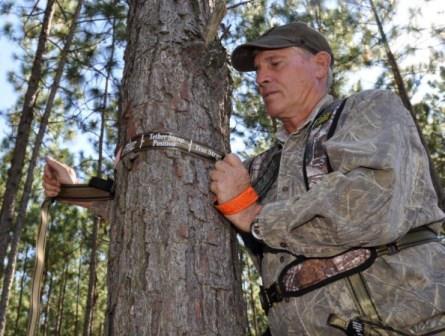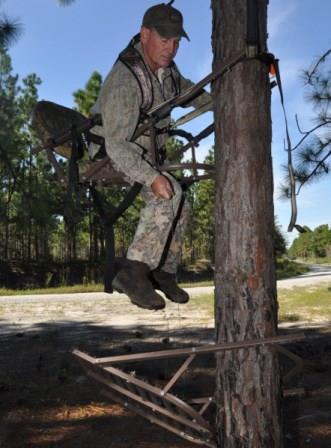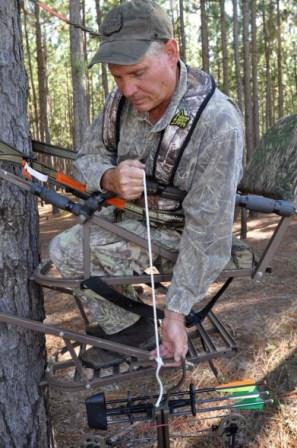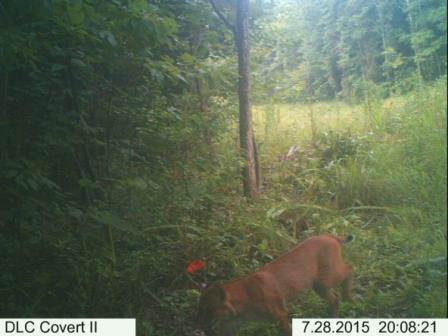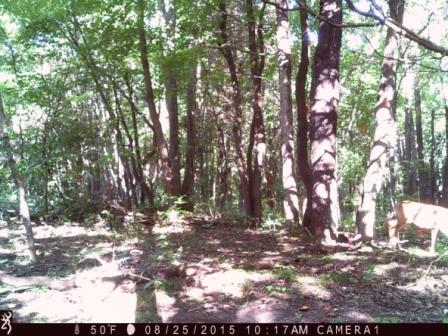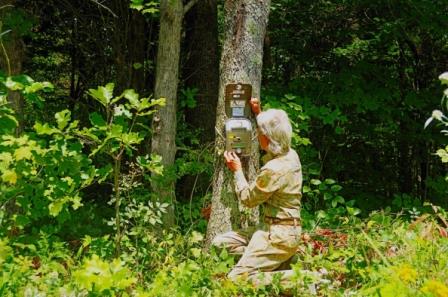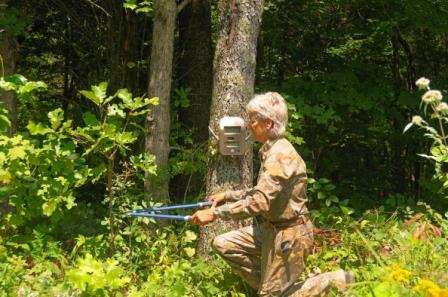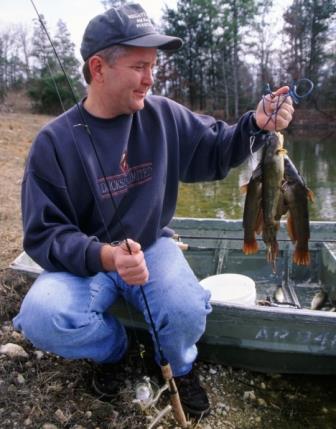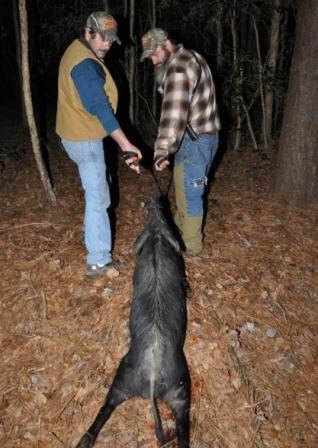By Mike Marsh
Six secrets to taming your crossbow’s
balance and weight!

Jerry Simmons hunts from an elevated stand with a crossbow. The sturdy rail keeps the crossbow steady and ready at all times to ensure a comfortable and enjoyable hunt. (Photo: Mike Marsh)
Hunters who use crossbows during archery season know that their accuracy and power come with some big tradeoffs. They lack the lightweight portability of a hand-held vertical bow and the easy maneuverability of a firearm. Plus, the length of the stock combined with the width of the limbs take up a great deal of space. And it’s cumbersome when carrying it to your stand.
Some hunters wonder why a crossbow needs to be so blasted heavy. The simple answer is that it needs a beefy frame to be powerful enough to take big game while handling its impressive release energy — without flying apart. That’s why a crossbow is heavy and cumbersome, which can nullify some of its advantages. Here’s how to deal with it.

This hunter is carrying his crossbow over his shoulder. Not only is it uncomfortable during long trips to the stand, but it also poses some risks. A better way to carry it is with a sling or inside a soft case that has a shoulder strap and hand-grip. (Photo: Mike Marsh)
1. Case it
Many hunters have learned to carry the crossbow in a soft case by the case’s shoulder strap when moving through the woods. Make sure your case has a handgrip as well. It will make it easier to maneuver through tight spots, or to hand off to another hunter. Wait until you arrive at your hunting site to remove the crossbow, cock it and load an arrow. The case will put an end to losing vital gear, and protect the crossbow from weather, spills and hard knocks. A case makes the entire weapons package much easier to carry.
2. Sling it
When travelling open country, carrying a crossbow with a sling is a convenient option. I use a padded sling with silicone rubber applied to the gripping side to keep the strap from slipping down my shoulder. I loop my cocking rope through the thumbhole stock and carry the crossbow with the quiver attached and the bow de-cocked and unloaded.
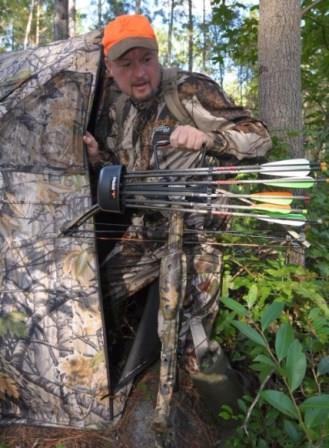
Chris House enters a ground blind with his crossbow. Many hunters discover that maneuvering a crossbow inside a ground blind is easier than in a tree stand. The trick is to pick a large, hub-style blind that allows you to shoot in any direction. (Photo: Mike Marsh)
3. Rail against instability
Every elevated stand I use for crossbow hunting has a rail for resting the crossbow’s forearm. Resting the forearm on the rail and the butt on my thigh allows me to control the crossbow at all times. Crossbows are front-heavy, and horizontal limbs make it unstable if you lean it against the side of a stand. It can suddenly rotate and bump the scope when you attempt to pick it up.
4. Don’t quibble with quivers
If you think a crossbow is cumbersome, why would you add a quiver and make it more awkward and unwieldy? The quiver adds weight and restricts maneuverability due to the nock-ends of arrows sticking beyond the bow. The easy solution is to remove the quiver before you cock the bow. Tie it to the treestand or put in the side pocket of a ground blind.
5. Go large
I usually hunt from a roomy, hub-style, cube shaped blind that has ample room to shoot from the front and strong side if I am sitting in a folding chair in one corner. I do not use a chair with arms because they interfere with resting and moving the butt and pistol grip. If game is approaching and far enough away to risk movement on my part, my blind is large enough that I can slide the chair around or kneel to take a shot in any direction.

The author usually hunts from a ground blind when using a crossbow. He uses a rest made from the top hub and metal supports of a beach tent canopy with a piece of a kid’s water noodle that has a section of PVC pipe through it center-bolted to the hub. The rest holds the crossbow at the ready and rotates 360 degrees. (Photo: Mike Marsh)
6. Give it a rest
When you are inside the blind, use a rest to hold the bow as well as stabilize it for shooting. A four-legged metal walking cane you can purchase at most drug stores for about $20 makes an inexpensive rest. The cane has a 90-degree, foam padded handgrip that’s perfect for resting the forearm of a crossbow. Its telescoping shaft has push-button stops to make it easy to adjust for height. I also have another favorite rest I made from a discarded beach tent frame with four metal supports and a plastic hub at the peak. After drilling a hole through the hub, I bolted in place a piece of a kid’s water noodle with a section of PVC pipe slipped inside it. The four-legged rest easily adjusts for height and rotates 360 degrees. I rest the forearm of my crossbow on it and hold the butt stock on my upper thigh, always ready to raise it smoothly and quickly to align the scope and take a shot.
Sometimes hunting with a new piece of gear is just a matter of learning to manage something you haven’t used before. And I’m betting if you get out, you’ll add your own tips to these six ideas that make hunting with a crossbow easier.
About Mike Marsh:
 Mike Marsh lives in Wilmington, N.C. and has written thousands of hunting and fishing articles for newspapers and magazines plus four books (“Fishing North Carolina,” autographed, inscribed, $26.60 ppd; “Inshore Angler-Carolina’s Small Boat Fishing Guide,” $26.20; “Offshore Angler-Coastal Carolina’s Mackerel Boat Fishing Guide,” $22.20; and “Carolina Hunting Adventures – Quest for the Limit,” $15, check or MO, 1502 Ebb Drive, Wilmington, NC 28409). His columns appear in Fayetteville, Raleigh, Wilmington, Goldsboro and other newspapers. To contact Mike, read his latest “Barbs and Blasts” articles or order his books online, visit www.mikemarshoutdoors.com.
Mike Marsh lives in Wilmington, N.C. and has written thousands of hunting and fishing articles for newspapers and magazines plus four books (“Fishing North Carolina,” autographed, inscribed, $26.60 ppd; “Inshore Angler-Carolina’s Small Boat Fishing Guide,” $26.20; “Offshore Angler-Coastal Carolina’s Mackerel Boat Fishing Guide,” $22.20; and “Carolina Hunting Adventures – Quest for the Limit,” $15, check or MO, 1502 Ebb Drive, Wilmington, NC 28409). His columns appear in Fayetteville, Raleigh, Wilmington, Goldsboro and other newspapers. To contact Mike, read his latest “Barbs and Blasts” articles or order his books online, visit www.mikemarshoutdoors.com.
6,018 total views, 1 views today




